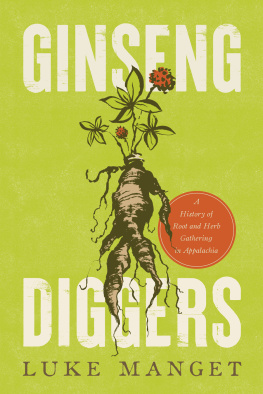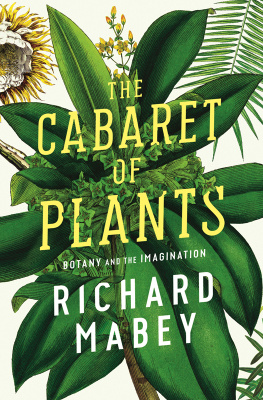GINSENG DREAMS
Publication of this volume was made possible in part by a grant
from the National Endowment for the Humanities.
Copyright 2006 by The University Press of Kentucky
Scholarly publisher for the Commonwealth,
serving Bellarmine University, Berea College, Centre
College of Kentucky, Eastern Kentucky University,
The Filson Historical Society, Georgetown College,
Kentucky Historical Society, Kentucky State University,
Morehead State University, Murray State University,
Northern Kentucky University, Transylvania University,
University of Kentucky, University of Louisville,
and Western Kentucky University.
All rights reserved.
Editorial and Sales Offices: The University Press of Kentucky
663 South Limestone Street, Lexington, Kentucky 40508-4008
www.kentuckypress.com
06 07 08 09 10 5 4 3 2 1
Photos and book index courtesy of Kevin Millham.
Illustration courtesy of Dan Dourson.
Library of Congress Cataloging-in-Publication Data
Johannsen, Kristin, 1957
Ginseng dreams : the secret world of Americas most valuable plant
/ Kristin Johannsen.
p. cm.
Includes bibliographical references and index.
ISBN-13: 978-0-8131-2384-4 (hardcover : alk. paper)
ISBN-10: 0-8131-2384-4 (hardcover : alk. paper)
1. American ginseng. I. Title.
SB295.G5J64 2006
633.88384dc22
2005034193
This book is printed on acid-free recycled paper meeting
the requirements of the American National Standard
for Permanence in Paper for Printed Library Materials.

Manufactured in the United States of America.

| Member of the Association of American University Presses |
CONTENTS
ACKNOWLEDGMENTS
I am tremendously grateful to all of these people, who were so generous with their time, knowledge, and insights: Gary and Beth Anderson, Kirk Baumann, Andrew Bentley, Dan Bond, Steve Bowling, Wendy Cass, James Chamberlain, Rock Cianciotti, Clare Comer, Jim Corbin, Pat Ford, Father Al Fritsch, Steve, Diane, and Seth Goodman, Joe Heil, Paul Hsu, Mary Hufford, Terry Jones, Father Jack Kieffer, Sherry Kilgore, Chris Kring, James McGraw, Laura Murphy, Scott Persons, Iris Riesen, Ann Rogers, Ginger Shelby, Sister Therese Tackett, Robert Watts, Skip Wissinger, Jo Wolf, and Syl Yunker. Wherever they speak in this book, their words have been quoted directly from recorded conversations. I have edited some of the conversations for clarity and brevity.
I greatly appreciate the help and hard-to-find information given to me by the Appalachian Ginseng Foundation, Appalachia-Science in the Public Interest, Berea College Archives, the Ginseng Board of Wisconsin, the Korean National Tourism Organization, the Lloyd Library of Cincinnati, Ohio, and the Marathon County Historical Society of Wausau, Wisconsin.
Special thanks go to my literary critics, Karen Johannsen-Talsky and Bob Cabin, who read and critiqued earlier drafts.
And above all, I would like to thank my parents, Walter and Marilyn Johannsen, for their support, and my husband, Kevin Millham, for his encouragement, and all those dinners, and for giving me that calendar in the first place.
May they all be well and happy!
INTRODUCTION
SCENES FROM THE GINSENG WORLD

Previous page: On Ko Shing Street in downtown Hong Kong, employees of a traditional Chinese medicine company sort and grade heaps of ginseng root.

Ko Shing Street, Hong Kong. Its a blazing morning in early September, with temperature and humidity both in the 90s. Take lots of water, our friend Iris warned us before we descended from her air-conditioned haven on the twenty-eighth floor. Wed spent the night before in her glass-walled guest room, and could hardly bear to sleep, the view was so enchanting, through the neon skyscrapers that parade down the steep slope to the harbor, out over the procession of freighters and junks and hydrofoils skimming the dim sheet of water, across to glittering Kowloon and beyond to the mountainous bulk of the Chinese mainland.
Seen from above, Hong Kong is gleaming and futuristic, a cool, high-tech, glass-and-steel machine. But at street level, its another matter entirely, steamy and seething with humanity. Just as was true many dynasties ago in China, each neighborhood and every street has its own trade, and in Ko Shing Street, a stones throw from the worlds second-tallest building, it is traditional medicines. A weird, chokingly sweet smell pours from the open fronts of the shops. Dried lizards are mounded next to heaps of huge, shiny tree fungus, chrysanthemum blossoms pressed into ruffled cakes, bundles of powdery sticks, and rows of earthenware jars crosshatched with Chinese characters.
But mostly, theres ginseng.
Barrels of it, sacks of it, bales of it stitched up in canvas. The other name for Ko Shing Street is Ginseng Street, and more of it is pouring in even as we gawk. By 9 A.M., the streets two lanes have become a parking lot for delivery trucks, and sweating laborers with towels wrapped around their heads are wrestling giant bales into the shops, or barging down the sidewalk with handcarts and shoving guys in suits out of the way. I nearly get bashed in the face with a sack as I cozy up hastily against a wall.
Many of the businesses on this street are ginseng wholesalers, each shop like a long, narrow tunnel stacked floor to ceiling with huge cardboard cartonsa kings ransom worth of the roots. Far at the back, there is a single desk, with a figure hunching intent over papers and calculator. In one office, I see three men in suits lean forward over a glass display counter, pointing and arguing with the proprietor behind it.
The retail shops are more colorful, stacked deep in gaudy red and gold cardboard boxes of ginseng roots, ginseng slices, ginseng powder, ginseng tonics. Some frilly, ancient roots are individually displayed in packages that look like picture frames. And many of them proudly, conspicuously bear the label American ginsengdecorated with the Stars and Stripes.
This Hong Kong street is the worlds main market for American ginseng. In 2000, more than three hundred tons of ginseng from the United States changed hands here, from Midwestern farms and Appalachian hollows.
Its a massive operation. In one of the shops, five men and women are seated at a long table buried under ginseng roots. I watch as they deftly break off the root-hairs, snap the ginseng into inch-long pieces, and then toss it into plastic baskets, dividing it by grade according to a system that is a tightly guarded secret. No one even sees me.
For over a billion Chineseone in every six of the Earths peopleginseng is the supreme medicine, one which strengthens every system of the human body, preventing disease and promoting longevity. The roots that arrive in this hot, noisy little street in Hong Kong will be processed, packaged, and shipped off to stores and pharmacies all across China, and to the Chinatowns of major cities around the world.
Next page









